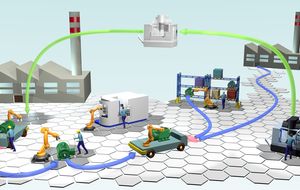KANBrief 4/19

As in other scenarios, worker safety must be assured in the transformable machines and production facilities of Industry 4.0. Owing to the high level of networked integration, consideration must be given not only to functional safety, but also to a greater degree to security against external attack, and to the mutual influences of the two. It must also be considered to what extent existing risk assessment methods will be suitable for the transformable machines of the future.
Our markets are destined to become substantially more dynamic and volatile. The constrained flexibility of today’s machinery and production plants will then no longer be economically viable. For this reason, machinery and production plants are being discussed for Industry 4.0 that are characterized by a high degree of transformability. This is attained by the facility for individual production modules to recombine themselves to form production islands and to be networked and configured automatically, on a job-by-job basis. This is achieved by individual modules (such as intelligent sensors) being networked with each other flexibly, and generally wirelessly.
The key technical building-blocks of Industry 4.0 are intelligent, digitally interconnected cyber-physical systems (CPSs). Like any conventional machine or installation, a CPS possesses operational functions by which the products are manufactured, and safety functions that assure the functional safety.
Where safety-related signals are transmitted over long distances or – in Industry 4.0 concepts – over wireless networks, suitable supplementary measures must be taken to prevent manipulation. If protection against attack (security) is inadequate and does not prevent a machine control system from being manipulated, networking of the installations may result in functional safety functions failing, and a hazard to workers arising as a result. Up to now, safety and security have been addressed by separate methods, since they have been subject to separate risk assessments. However, owing to the potential mutual influence of the two aspects, the occupational safety and health community considers it necessary for them to be examined together. This is the subject of current research at the German Federal Institute of Occupational Safety and Health (BAuA).
Safety analysis of CPSs presents new challenges for the risk analysis methodology. Consideration must be given for example to structural aspects (heterogeneity, interoperability, software intensity, networking, etc.) and dynamic aspects (time-sensitive developments, dynamic reconfiguration, autonomous decisions, etc.). In addition, existing safety standards assume that a system has been fully developed and configured before it is accepted and homologated (refer in particular to IEC 61508-3:2010).
In a current project, the BAuA is aiming to evaluate whether traditional and modern risk analysis methods are suitable for application to transformable production systems. In a subsequent phase, suitable measures are to be tested in practice on digital system models of networked production or manufacturing installations.
Transformable manufacturing systems may also include machine learning (ML) algorithms. In this case, a distinction must be drawn according to the function performed by the ML algorithm. This may be:
For each of these three usage scenarios, which may overlap in parts, the safety-critical aspects must be studied in detail. The BAuA is currently studying how the unpredictability of the decision results delivered by ML algorithms, which differ in this respect from traditional software components, can be described in future in a quantitative risk analysis.
Standardization can make a valuable contribution in these unresolved issues and support the methodical procedure produced by the various specialist disciplines. The research and development community, state regulators and standardization bodies must work together from an early stage in order for the potential presented by the digital technologies to be exploited in the interests of added value.
Dipl.-Ing. Björn Kasper
Dr. Silvia Vock
Dr. Stefan Voß
Federal Institute of Occupational Safety and Health (BAuA), Dresden
info-zentrum@baua.bund.de